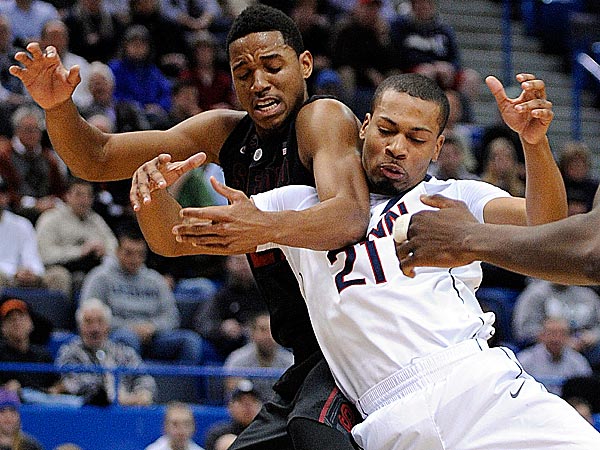Does UConn Have A Shooting Problem?
Posted by mlemaire on December 20th, 2013As UConn was ripping off nine straight wins to start the season and point guard Shabazz Napier was asserting himself as an early front-runner for National Player of the Year honors, smart college basketball viewers were pointing to the team’s absurdly good shooting percentages and urging caution before booking reservations to the Final Four. Sports Illustrated‘s Luke Winn may have not been the first person to realize that the Huskies’ astonishing accuracy from downtown was a legitimate red flag, but he was the first to do the appropriate research and put it into a handy table. In the first nine games of the 2013-14 season, the Huskies have transformed themselves from a mediocre three-point shooting team into an incredible three-point shooting team. It would be wonderful if we could point to the stats and applaud the Huskies’ players for working hard in the offseason on becoming better shooters, but there might not be an element of basketball that is more prone to regression than shooting percentages. And to some extent, that regression was in full effect last night as UConn lost its first game of the season to Stanford.

Shabazz Napier has been red-hot from downtown this season, but he may be better off attacking the rim more often.
The team entered the game shooting better than 46 percent from behind the three-point arc and things started out as planned when the Huskies jumped out to a 10-point lead thanks to 6-of-10 shooting from downtown. The lead ballooned to 13 early in the second half and it looked like the Huskies were on their way to another impressive win; that is, until they went ice cold from pretty much every spot on the floor. Whether it was Stanford’s defense or just some natural regression (and it was likely a bit of both), the Huskies were abysmal from the field in the second half, missing all 12 of their three-point attempts and shooting just 5-of-31 (16 percent) overall. The shooting woes allowed the Cardinal, which boasts an efficient but not especially dangerous offense, an opportunity to claw back into the game and eventually win despite missing numerous opportunities to seal the victory at the three-point line.
Some fans might be willing to brush off the ugly second half as bad luck combined with questionable shot selection (those three late three-point attempts from Napier were not good shots), and that may be true to an extent, but smarter UConn fans know better. They know that their team has been unsustainably hot from behind the three-point arc and they are worried that the team’s fast start is going to slow down considerably as the competition gets better and the team’s shooters regress towards the mean. The question going forward is whether UConn is actually a better shooting team this season or has it just been able to mask mediocrity thanks to a combination of good luck and easy opponents? Let’s compromise for a minute and partially agree on both counts — that the Huskies are a better shooting basketball team, and that some regression is inevitable and unavoidable. But even given the hot outside shooting, the team is still middle-of-the road in terms of offensive efficiency and it’s safe to say that the Huskies shouldn’t rely on interior offense at any point during the season. So what can Kevin Ollie do to make sure his offense doesn’t completely fall apart as the shooting percentages even out?
Well, we can start with the obvious and point out that it’s probably time to stop giving Omar Calhoun free rein to just jack up triples as he sees fit. The sophomore is ostensibly a good three-point shooter (41.7% this season), but he made just 32 percent of his three-point shots last season and is on pace to slightly eclipse last season’s total attempts this season. I guess maybe regression to the mean could work in the Huskies favor on this one but it’s probably best to let someone else siphon off a few of those shots that Calhoun has been taking. The second adjustment is to politely ask Napier and Boatright to attack the rim a little more often. Boatright is already doing this as more than one-third of his shots have come at the rim and he is making 57.1 percent on those attempts (according to Hoop-Math.com). But Boatright’s best asset has never been his shooting ability, and more than a quarter of his shots have come from behind the arc. He has no doubt been great from there so far this season, but of all the players shooting over their heads, Boatright and maybe Niels Giffey (65.5%) are the true poster boys for regression.
Napier is a dynamic offensive player with above-average shooting ability, so this isn’t a plea for him to abandon his jump shot. But he is also one of the strongest guards in the country, making nearly 58 percent of his shots at the rim despite the fact that just one in five of his shots are there. The real problem is that he takes a bunch of long two-point jump shots, which he makes them at a significantly lower rate (47.8%). He is the type of guard that is impossible to keep out of lane and difficult to knock off-balance, so it makes sense for him to attack the rim more often than not. These little changes aren’t going to drastically improve the Huskies’ offense nor is it meant to implore these players to fundamentally change their offensive approaches (except Calhoun, who really does need to stop shooting so many threes), but the Huskies are already a top 20 defensive outfit and if they can find a way to be more effective offensively away from the three-point line, they may rejuvenate those Final Four hopes just yet.










































